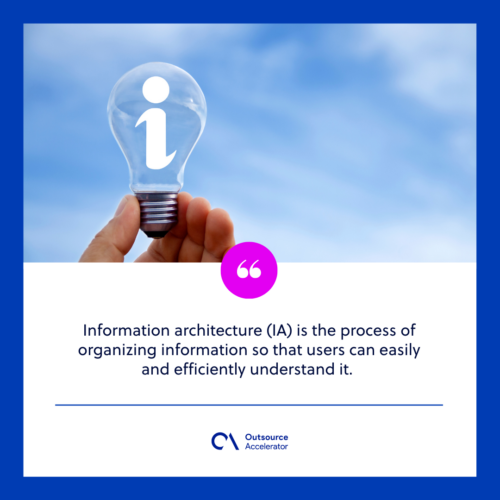Key steps in an information architecture plan

Consumers today want content. It’s been one of the most important and effective strategies companies use to market their brand. However, only the best are able to use proper information architecture to deliver content effectively.
Imagine prospects who come to your website and are instantly bombarded by overwhelming content. They don’t know where to get what they’re looking for or find solutions to their issues. Information architecture will help provide structure to your site’s content.
Because the role of information architects is mostly done online, many companies choose to outsource this work. Eclaro is among the premier outsourcing firms that supply teams of information architects offshore.
What is information architecture?
Information architecture (IA) is the process of organizing information so that users can easily and efficiently understand it.
The goal is to design a structure that makes sense and provides an effective way for users to navigate through content.
Information architecture is a subset of user experience (UX). The latter includes everything that happens between the user and the final product.
A well-designed information architecture makes it easy for users to understand how your site works without getting lost or frustrated.

Steps in an information architecture plan
Information architects follow a planning model so that all bases are covered when designing ways to access content.
Here we have the steps in an information architecture plan:
Conduct user research
The first step in an information architecture plan is to conduct user research.
User research is a process of analyzing users and their needs. It involves observing the target audience and asking them how they currently use your product or service.
The data collected should help you understand what users need from an information architecture and what goals they want to achieve when using it.
Content inventory, grouping, and audit
This step deals with existing content, providing value to users and search engines. The tasks related to content are as follows:
- Content inventory. The inventory of pages, images, and other elements on your website.
- Content grouping. The structure of the content inventory, including how it’s divided into sections and subsections.
- Content audit. A list of all the content pages on your site, along with their purpose and value to users.

Taxonomies and labeling
The taxonomy is a controlled vocabulary used to organize content on your site. It can be hierarchical (like a tree) or more like an outline with sections or subsections.
Another important aspect of IA planning is labeling — deciding what words to use to describe different types of content. It also includes figuring out how those words are grouped in a meaningful way so users can easily find what they’re looking for when they visit your site.
Create hierarchy and navigation
To create the hierarchy of information, information architects should anticipate what the user wants to see. A relevant content arrangement should follow that blueprint.
Next, create an outline for how users will navigate. The navigation should be simple enough that anyone who visits your site can easily find what they’re looking for without getting lost in a sea of links or menus.
Prototyping
When the information architecture has been outlined, it’s time to create an interactive prototype. This helps you get feedback from others on your ideas before investing too much time and energy into them.
Prototyping is one of the most important steps in the process. Your prototype will be used for important testing. Prototypes can be low-fidelity (paper sketches) or high-fidelity (computer-generated images).
User testing
Testing can be done at any stage of the information architecture plan, but it is most useful here. Once the prototype is done, it can be tested to detect any issues. By this point, any redesigns should be minor.
Let Eclaro handle information architecture for your business
Tap into Eclaro’s resource of highly-skilled IT and business professionals to provide your information architecture designs.
Eclaro offers custom outsourcing solutions depending on your staffing requirements.
You maintain operational control while an offshore team in the Philippines handles your information architecture projects.
To top it all off, save up to 75% in costs without sacrificing professional quality!
Take advantage of the IT/BPO culture and resources in the Philippines with Eclaro.







 Independent
Independent




